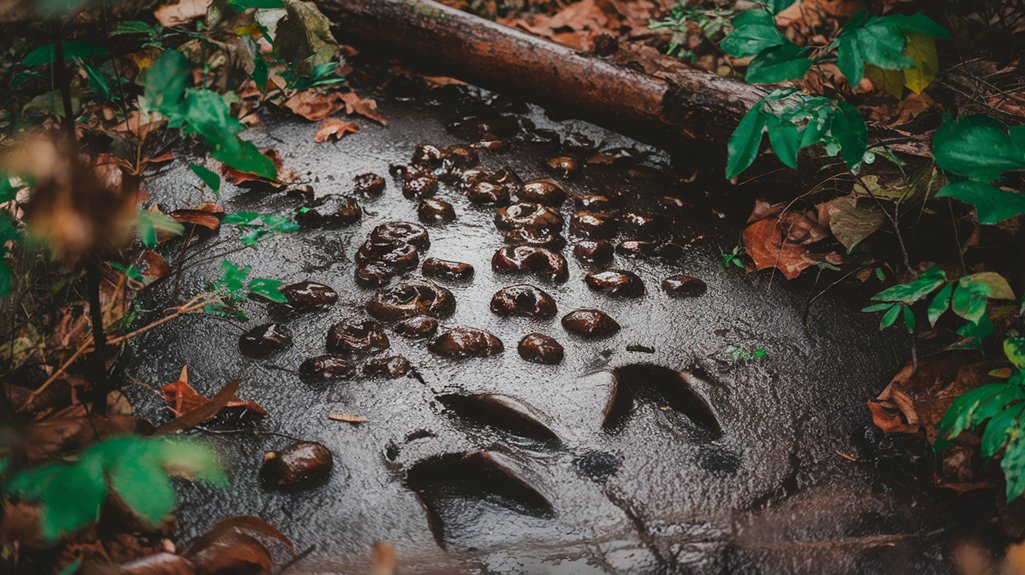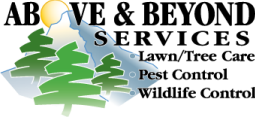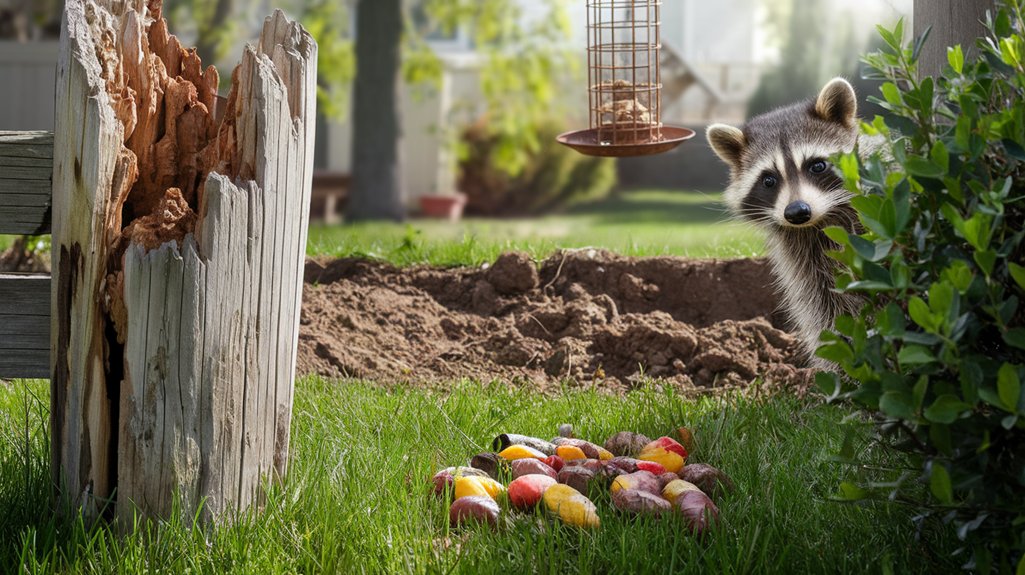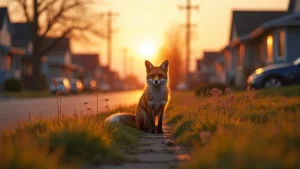If you’ve noticed strange nighttime sounds or unusual droppings around your home, you might be dealing with a wildlife problem. These signs can indicate that animals are making themselves at home in your space. Ignoring them could lead to bigger issues. So, what should you look for next? Understanding the specific signs can help you address the situation quickly and effectively. Let’s explore the crucial indicators that could save your home from further damage.
Unexplained Noises at Night

Have you ever been startled awake by strange sounds outside your window? Those noises might be coming from nocturnal creatures roaming your yard.
Sound identification can help you figure out what’s causing the ruckus. You might hear rustling leaves, soft scurrying, or even eerie calls—each signaling different wildlife activity. Common culprits include raccoons rummaging for food, owls hooting, or even foxes howling.
If you’re unsure about the source, try recording the sounds. Later, you can compare them to online resources or local wildlife guides. Recognizing these noises not only eases your worries, but it also helps you understand if there’s a wildlife problem that needs addressing.
Stay alert and listen closely; nature can be both fascinating and unsettling at night.
Unusual Droppings and Tracks

Strange sounds aren’t the only signs that wildlife might be visiting your yard; unusual droppings and tracks can offer valuable clues too.
When you spot droppings, don’t just ignore them—do a bit of droppings analysis. Different animals leave distinct droppings, so identifying the species can help you determine the best way to handle the situation. Look for size, shape, and content.
Similarly, tracks can reveal what creatures are roaming around your property. Pay attention to the size, number of toes, and patterns. This wildlife identification can guide you in implementing effective solutions.
If you find evidence of wildlife, consider using humane traps or contacting professionals to assist in resolving the issue swiftly and safely.
Wildlife Problem Signs demand quick action. Learn wildlife tips from Colorado Parks and Wildlife.
Signs of Chewing and Gnawing

While exploring your property, you might notice signs of chewing and gnawing that indicate wildlife is nearby.
Look for distinct chewing patterns on wood, wires, or furniture, which can signal the presence of animals like rodents or squirrels.
Check various gnawing locations, such as fences, tree trunks, and even the corners of your home.
If you spot small tooth marks or damaged surfaces, it’s a clear sign that critters are making their presence known.
Pay attention to the frequency and severity of these signs, as they can help you determine how urgent the situation is.
Addressing these issues quickly can prevent further damage and keep wildlife from becoming a bigger problem on your property.
Damaged Landscaping and Garden
One clear indication that wildlife is visiting your property is the damage to your landscaping and garden. If you notice garden destruction, it’s time to act.
Here are some signs to watch for:
- Uprooted plants – Look for plants that have been disturbed or completely removed.
- Uneaten fruits or vegetables – Find discarded produce that wildlife may have nibbled on.
- Footprints or trails – Identify animal tracks in your garden beds or pathways.
- Nibbled leaves – Check for bites taken out of leaves and flowers.
To protect your plants, consider using wildlife deterrents like motion-activated sprinklers or natural repellents.
Taking these steps can help restore your garden and keep unwanted visitors away.
Increased Pest Activity Inside Your Home
If you’ve noticed damage to your landscaping, it might not be long before wildlife starts making its way indoors. Increased pest activity can signal a bigger problem. Here are some common signs to watch for:
| Signs of Pest Activity | Pest Identification Methods |
|---|---|
| Droppings or urine stains | Inspect areas where pests may hide |
| Gnaw marks on furniture | Use traps to catch and identify pests |
| Strange noises at night | Monitor for movement and activity |
To address this issue, focus on indoor pest prevention. Seal entry points, keep food stored properly, and maintain cleanliness. Regularly check for signs of pests and employ pest identification methods to tackle any infestations quickly. Don’t wait—act fast to protect your home!
Frequently Asked Questions
What Types of Wildlife Are Common in Urban Areas?
In urban areas, you’ll often encounter urban wildlife like raccoons, squirrels, and pigeons. These common pests adapt well to city life, scavenging for food and finding shelter in buildings, parks, and garbage bins.
How Can I Prevent Wildlife From Entering My Home?
To prevent wildlife from entering your home, use exclusion methods like sealing gaps and installing screens. Additionally, consider habitat modification by removing food sources and shelter around your property, making it less inviting for unwanted critters.
Are There Humane Ways to Remove Wildlife?
Yes, there’re humane ways to remove wildlife. You can use humane traps to capture them safely and employ exclusion methods to seal entry points, preventing future visitors. It’s essential to act quickly and responsibly.
When Should I Call a Professional Wildlife Removal Service?
If you notice wildlife signs like droppings or noises, don’t wait too long. Removal urgency increases if animals pose health risks or cause property damage. Call a professional wildlife removal service as soon as possible.
Can Wildlife Problems Cause Health Issues for My Family?
Yes, wildlife problems can cause health issues for your family. Wildlife diseases can spread through pests, creating risks. You should consider pest control measures to protect your loved ones from potential hazards associated with wildlife infestations.
If you notice any of these signs, it’s time to take action. Don’t wait for the problem to escalate—identify the wildlife causing the issues, and consider humane traps or professional help. Remember to seal any entry points to prevent future intrusions and use deterrents to protect your garden. By staying alert and proactive, you can keep your home safe and your outdoor spaces thriving. Take control of the situation before it becomes a bigger headache!
Contact Us
Wildlife Problem Signs need fast fixes. Above & Beyond Services provides humane wildlife removal in Denver. Call (720) 806-6378 or visit Above & Beyond Services for free quotes on wildlife control, pest management, and more.
Key Takeaways
- Unexplained Noises at Night: Listen for rustling, scurrying, or eerie calls, which may indicate nocturnal wildlife nearby.
- Unusual Droppings and Tracks: Examine droppings and footprints for size and shape to identify the species present on your property.
- Signs of Chewing and Gnawing: Look for distinct tooth marks on wood or furniture; these indicate wildlife is causing damage and requires immediate attention.
- Damaged Landscaping and Garden: Check for uprooted plants or nibbled leaves, as these signs suggest wildlife foraging in your garden.
- Increased Pest Activity Inside Your Home: Monitor for droppings or gnaw marks indoors, indicating that wildlife may be entering your home and needs to be addressed promptly.




